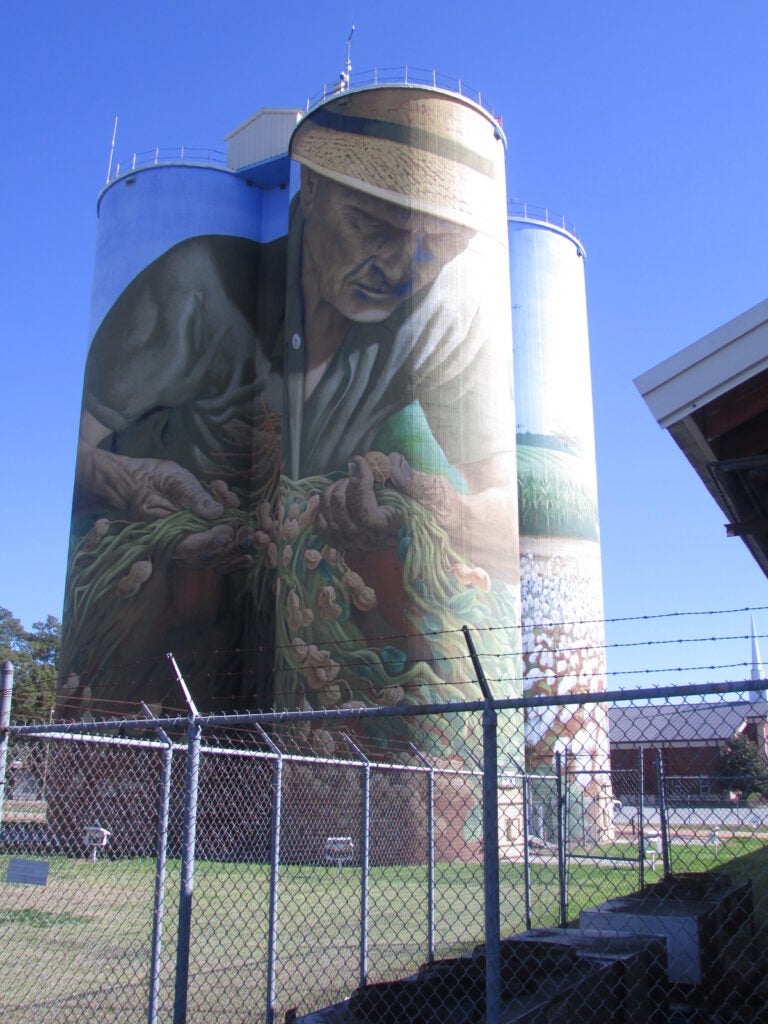Stories Told by Murals
Published 2:28 pm Sunday, March 10, 2024
|
Getting your Trinity Audio player ready...
|
“If these walls could talk”, became the motto of the town of Colquitt in 1999. This all happened because of the success of the folklore play, “Swamp Gravy”.
The Colquitt/ Miller Arts Council wanted to go a step farther, showing how pleasant it was to live in a small, Southern town. Using the inspiration of the Swamp Gravy stories, murals would be painted throughout the town. This artwork would be the best way to visually depict these real-life stories.
Since these folklore tales were becoming very popular to those who lived in southwest Georgia, as well as visitors, they could have a huge, positive impact on the community. The council decided to call this new endeavor the Millennium Project, since it was to start in 1999.
The next step was that the Colquitt/ Miller Arts Council applied for, and received, a grant from the National Endowment for the Arts – Artist and Communities Millennium Grant. Each year the NEA chooses one arts organization from each of the fifty states and the artists, who were then commissioned to paint the murals.
The art work proved to be very successful and in 2006, Colquitt was declared Georgia’s first Mural City by the State Legislature. In August, 2006, members of the Mural Committee traveled to Edinburgh, Scotland, where they won the bid to host the 2010 Global Mural Art and Cultural Tourism Association Conference. Their Millennium Project was off and running.
Stories presented in pictures are now bringing vivid color everywhere. Just walking around the town square, you will see bigger than life murals and more scenes are always being added to the walls of other buildings, in other places in town. Art is telling the stories of the past.
The first mural painted was done in 1999, by Henry Lee Gorham of McRae, Georgia. It is called, “Saturday Morning in Colquitt, Georgia”. The story that inspired this mural is what a typical Saturday morning on East Main Street, during the late 1930s, was like.
Looking on the left side of the painting, you will see, “Nug’s Café”, a place that pulls at the heart strings of many residents. You know there is one such place in every small Southern town, where the home style cooking attracts a herd of patrons. During the day, Nug’s Cafe was THE place to meet with friends for lunch. Then, on Saturday nights, Nug’s changed its personality, as the jute box blared out the popular music of the day. It became a place for kicking up your boots on the dance floor. It is said, that anyone who wanted to partake in a little partnership could find it at “Nug’s”.
The mural, “Neighbors”, was the first one painted in Colquitt by Dothan, Alabama, artist Wes Harden. Done in November, 2000, you will find it on a wall of a building near Cotton Hall. This is the true story of a farmer who had broken his back and was unable to work his farm. In true Southern fashion, neighbors came to his aid and helped their friend. The painting shows the children sharing in the chores as neighbors are seen coming to help, bringing wagon loads of tools and food. According to that farmer, “It was my neighbors who did not turn their back and that made me smile”.
Some of the stories recall fun times, like the “Bull Comes to Colquitt”. This too, was painted by Wes Hardin, in 2001. It tells a story that took place in the 1920s, about a man named Mr. Johnnie, who had a barn and a cow pen, located on South Cuthbert Street, about a block away from the square. Not only did he keep cows, he also had a very large brown and white bull too. Nearby, where the Tarrier Inn stands now, was where the community water troughs were located. A frequent visitor to the horse trough was this bull. When he felt social, he would come to town and interact with everyone there. He did not realize that he was different from everyone else.
Now, it was common for the merchants to put some of their merchandise outside on the sidewalk. However, when the bull got the urge to go shopping, they needed some type of warning. The first line of defense was the workmen at a sawmill, that was on the edge of the square. The minute that they would see him, they would begin hollering, “The bulls out!”. When this was heard, folks would run for cover and store owners would grab their wares and bring them inside their shops.
No one could get the bull back to his home but Mr. Johnnie. If he was not at home, the bull would just stroll around town until Mr. Johnnie came and took him back to what was his home. Once there, the bull would stay, until the urge for companionship came upon him again.
Another of Mr. Hardin’s panels is the kind of story that many folks can relate to. It is about a young man who left home to fight in World War II. However, it could be about anyone, who has a family member who had gone off to War.
For eight years after World War II, one of Colquitt’s young men was missing in action. His father traveled all over to find him, a search that brought him to France. Before the father left, he told his wife, “If I don’t find him, I’ll call you and say, “ l’ll be home for dinner”. One day, she got that call. She met her husband at the train, only to see her son arrive in a flag draped coffin.
Another panel in Hardin’s mural shows the excitement that crackled through the town in the 1920s, when the circus arrived. For one Miller County couple, it’s a special memory.
A young man got up the nerve to ask a young lady out on a first date with him. At first, the young man asked about going to a movie. She said, “No”. He then suggested driving around. Again, a “No”, because just “driving around” was not respectable. The young man was desperate and he blurted out, “The circus is coming to town. Would you like to go?” The answer was an enthusiastic, “Yes!”. Now, after being married for many years, they both agreed, it has been a three-ring circus ever since.
Artist, Chrissie Orr, from Santa Fe, New Mexico, takes a different approach to life in her murals. Most notable is, “We’ve Got A Story To Tell”. This huge mural was painted by Chrissie in December, 2000, on the north side of the Rite Aid Pharmacy, which is now Walgreens.
Brightly colored, her images show the melting of the three dominant cultures of the South: Caucasian, African American and Native American. All life styles are depicted by symbols under sepia-colored arches. Portrayed at the base of these arches are native plants and crops, while the circles at the top are insects beneficial to agriculture. Between the pillars of the arches, are the folks who work the land, symbolizing the important role that the farmer plays in the community and the entire state of Georgia. Also, many of the Swamp Gravy stories are woven into this mural.
Another of Chrissie’s murals is called, the “Peace Wall”. This was painted in May, 2000. Chrissie did not do this one alone but had over 300 volunteers, which included students, faculty administrators and other community members. In these scenes, the students tell what peace means to them. In a glorious burst of color, there are many peaceful symbols, which include doves, fish, waterlilies, pine trees and other local plants. Oval medallions, that were designed by sixth graders, tell what each student’s version of peace is. This one is located on the front of the Miller County Midde School on Perry Drive.
The next mural was completed in 2004. These are stories told by students about their experiences at Spring Creek. Artist Cheryl Hardin, of Hurtsboro, Alabama, included the children from the beginning, urging them to tell of their adventures. Then, she helped the children paint them. This mural can be seen on the New Life Learning Center’s wall.
One story tells of a young boy and his father, who went fishing and forgot their fish stringer. When the fish started biting, they had to put their catch anywhere they could, which included their pockets and the tackle box.
Another story in this mural is that of a little girl and her family, who went out fishing in their boat. However, there was not room enough for their dog, so they left him on the bank. The dog had other ideas and wanted a boat ride. He began to swim out to them, when a nearby alligator saw what he though was going to be an easy meal. When the gator went for the dog, the girl whacked the surprised reptile on the head so hard, that she broke the paddle! This did give the dog enough time to get pulled into the boat.
Purple shoes are at the center of another story. Two children had put them on the bank at Spring Creek, while they went swimming. When they went to get them, they got a startling surprise. A fashion-conscious cotton mouth had decided that he wanted to wear them!
Lastly, we cannot ignore Whites Bridge. Even today, it is known as the most haunted place in Miller County and southwest Georgia. Therefore, it is only right that four of its most famous stories be depicted in murals on the walls of Ghost Story Alley, which is by the fire station. These were painted by Henry Gorham in 2002.
The first is about an avid outdoorsman and takes place in Batts Hammock. In his younger days, this man enjoyed going out into the dense woods, where the trees were so large that it would take two men just to reach around one. It is also said that back in the day, it was a place that was as untouched as when the Indians found it.
One day, the outdoorsman was hunting, when he heard a noise coming out of the woods. A man dressed in black appeared, dragging a large heavy canvas bag. The man would drag it for a while, then put it down, look around and go on a few more feet. Eventually, he was out of sight. No one ever found out who the man was or what was so heavy in that bag.
No one can forget the original story of the White’s Bridge ghost. It seems that a young bride was to be married at Pilgrims’ Rest Church, which is adjacent to Spring Creek and an old cemetery. However, her fiancé had left her standing alone at the altar. She was so heart broken, that she jumped from the bridge into the swift running waters of the creek below.
For many years and even now, strange lights that look like orbs, have been seen floating around the church and over the cemetery. It is believed that this is the spirit of the heart broken bride still looking for her lover. However, there are others that say it is the spirit of the groom, wanting to explain to his love, what happed to him, on that day.
Our last story is perhaps one of the scariest. It is about a red-haired woman who was buried alive. Back in the early 1900s, bodies were not embalmed and there is no telling how many folks were buried alive. This woman was one of them. For some unknown reason, her body was exhumed. When her coffin was opened, what a surprise! The corpse had both of her hands full of red hair! She must have awakened and in her hysteria pulled out her hair.
After seeing this mural, a little girl told her father how terrified she was by this story. To comfort her, he told her that if she died, he would bury her with a telephone inside with her, so she could call him and he would come to her rescue.
There are many other murals that I have not touched on and the number is constantly growing with the most recent one a tribute to the famer, that is painted on the tall grain towers, just north of the square.






